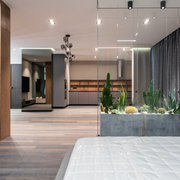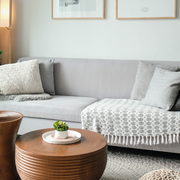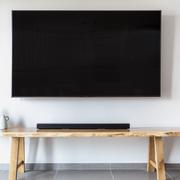The Best TV Wall Mount Ideas in 2020

Maybe you’ve just moved or maybe you’re tired of staring at the same four walls while housebound in the pandemic. Either way, you’re ready to refresh the decor, or perhaps move around the furniture, to get a new look.
It makes sense to start with the spaces you spend the most time in—the living room, the bedroom, the den. Also, we’re betting your Netflix subscription has been netting its money’s worth.
So, we suggest that you start your redecorating with the TV wall, updating your TV placement and decor—after all, if that’s where you are looking every day, it may as well be the best view in the house, whether the TV is on or off.
One of the choices you’ll want to make is whether to have your TV wall mounted or have it sit on a media console, dresser, or other piece of furniture. Naturally, we have some thoughts on this.
The Allure of a Wall-Mounted TV
Our recommendation is always for a wall-mounted TV, even if you do want a media console under it. Here’s why:
- It makes the surfaces below—be it a console, a credenza, or just the floor—a lot easier to clean.
- It leaves those same surfaces free for other uses, practical or decorative.
- It makes it easier to access the TV itself and its wiring for repairs, cleaning, and moving.
- With the right pull down TV mount—namely, MantelMount—you get far more flexibility on angle and height adjustments than you can manage with a TV stand. With a stand, you cannot customize much for different individuals, or even the same viewer, moving around the room.
- A wall mount also offers far more versatility for decor around it, because you don’t have to worry about the piece of furniture supporting your TV being large or sturdy enough—this means you can choose period pieces, more lightweight, or minimalist options.
- It’s a better bet by far for tight spaces, or when your TV wall is along a high-traffic path—like on a wall between two doors.
- You can also raise it out of reach of children and pets!
- Whatever height you choose, a wall-mounted TV eliminates tipping risks. This is safer for people and safer for the TV, too, especially if you spent a large chunk of cash on it.
We trust you are now convinced that the way your TV goes should be up—up on the wall! Now, let’s brainstorm placement and design.
Placement of your Wall-Mounted TV
The most important factors you want to consider when placing your TV are the size of it, the size and shape of the room, and where you will be sitting—or lying!—when you watch.
Choosing a TV wall mount with a built-in tilt, and especially the option to lower the TV, will help when you go from sitting up in bed to slouching on the floor with your pet or toddler. MantelMount’s wall mount options can lower the TV by up to 27 inches!
TV Size
You might be wondering, “How high should I mount a flat-screen TV?” If you have a broader screen, it is better off mounted a little higher for a better viewing angle. This way, objects placed on furniture below—or people sitting in front of or across from you—don’t have a chance to obscure the lower edge.
Room Size
You should be sitting about twice the distance from your TV wall as your TV’s size—so, a 60-inch TV calls for you to sit 10 feet (120 inches) away. This, in turn, can dictate which wall works best for the TV mount.
Besides, a wider room, especially one zoned for different activities, can call for a larger swivel angle from the TV mount—more so if your TV is on the longest wall.
Function and Furniture Placement
When choosing which wall to mount your TV on, consider the placement in terms of how you use the room, as well as how light hits the wall you are considering by day and by night:
- Mounting between windows can be best to avoid glare—unless you have a lot of ambient streetlight that gets in your eyes!
- Can you use blinds to cut out glare from a nearby window, or do you prefer more daylight?
- Can you move around lamps or redirect spotlights by night?
- If you prefer to watch movies with the lights dimmed, which TV wall makes it less likely for someone to trip on furniture when they go to get a drink?
- How likely is someone to cut across your sightline? You don’t want to be sitting on the couch with a dining table between you and your TV—interruptions are guaranteed. Similarly, if your favorite recliner is positioned on one side of a doorway and the TV on the other, how often does someone stroll in and cross the room?
- If you’re a serious audiophile, you may need to consider the conflict with existing sound equipment and the acoustics of the room.
- Think hard about whether you really need a wall-mounted TV shelf just underneath. We know it’s a common arrangement. But, you chose freedom from furniture when you did away with the stand. So, unless it is making a visual point, we have better ideas for storage on that wall below!
Let’s move on to room-specific decor for our two favorite TV-viewing spots: the bedroom and the living room (also applicable to the den).
Wall-mounted TV Ideas for the Bedroom
If your bedtime routine ends with the remote control, here are some of our favorite TV placements:
- Over the dresser: Because most of us have one, and it is often across from the foot of the bed, this makes sense. Should you want more artwork or storage on the same wall, incorporate the TV into your gallery as just another frame. Let the dresser cue where to place the remote by day, too!
- On the wall, over the bed: If you have a small bedroom, you might mount the TV directly over the foot of the bed, or you might have it on the wall your bed is pushed up against lengthwise, so that you can watch from your favorite lounge chair across the room.
- Over the head of the bed! Now, hear us out—some of us have partners who don’t appreciate the distraction at their feet. Get them a sleep mask, or move the bed a little further off the wall, and place the TV behind the headboard—et voila! Less light from the TV will reach them while they sleep. For yourself, invest in a cozy couch on the far wall—and headphones, of course.
- On the wall opposite the bed: This will make excellent sense if you have a convertible sofa or daybed. Use the space as a living space, as well as sleeping there at night.
- Higher than your climber toddler: If this TV is going in the kids’ bedroom, place it higher than the shelves your youngest is likely to climb. This is one room where you do not want it anywhere near the bed! (We know kids get bouncy in their castle!)
- Instead of art: This is the room where you may most want a TV that looks less like tech, so the non-intrusive design of one of the new frame TVs could be for you. Samsung is the leader of these TVs that look just like art when switched off, thanks to the bevel-edged cabinet and white border on the aptly named The Frame. This one resembles mounted artwork, but others, like Sony, LG, TCL, Vizio, Sharp, and Hisense, are doing these slender-bezel TVs, too. There’s even the rotating Sero from Samsung, which looks like an easel in a corner. Alternatively, consider LG’s roll-up screen, which allows the cabinet to even sit right at the foot of the bed or under a window, without disrupting your view.
- Mirror, mirror, on the wall… Is that a TV, after all? Try a mirror TV, which is literally a looking glass in idle mode, and a perfectly logical accessory in the bedroom, above the dresser! Samsung, Loewe, LG, and Sony are some brands that manufacture these. This is also the TV that can hang across from the bathtub.
Wall-mounted TV Ideas for the Living Room
Chances are the TV is sharing space with many more activity centers in your living room—this might be the place for family movie nights, or a solo binge-watching saga, but it may also hold the kids’ play area, your pet’s favorite nap spot, the family board games, your music, your knitting… and maybe your dining area. For some of us, this is our home office by day, too!
There’s a lot going on, so it can be hard to decide where to focus. Consider:
- Space-sharing with other tech: Do you also use the room for homework, a home office, and so forth? Would you want the TV recessed to allow for a sliding whiteboard, say? If you already use that equipment, you can save wall space by putting both on the same wall.
- Insert in the dip between taller cabinets: Can you move book shelves or other taller furniture apart to balance them visually on either side of the TV? It’s the natural resting place for your eyes, as they travel from corner to corner. Or, put it between pillars and bridge them with a long shelf to underline that flat-screen! You can do the same bracketing with tall plants or framed portraits.
- Call it modern art: Integrate the TV into a gallery of artwork and mirrors—it can even be off-center within the arrangement of frames, as long as the overall shape of your gallery squares up.
- Make it a son et lumière: Got a sound bar in the same room? Use it under the TV like a shelf to underscore the screen! There’s less visual clutter and it’s also more compact. (Chances are the acoustics will replicate well, too!)
- Visual buffet over the breakfast bar: This isn’t everyone’s cup of tea, but if you have one of those busy households where everyone’s catching up on the game or the news, then you may as well put the TV on the far wall!
- Send it to the naughty corner: If you’re really short of space for sitting or viewing, consider a cater-corner mount.
- Beyond the big couch: Is it practical for some people to be reading or pursuing other hobbies with their backs to the TV? If so, you can have the TV mounted behind one couch, facing your other sofas.
Integrate your Wall-mounted TV with Existing Shelves, Art, and Cabinetry
Just because you wall-mounted your TV does not mean it has to dominate your decor. If you prefer your media consumption to stay a little low-key, or just need a lot more storage to share your TV’s wall space, you might want to try one of these ideas for integrating your wall-mounted TV into the existing decor:
- Frame it or curtain it: A recessed TV allows you to shut doors or curtains over it when not in use. Borrow the veneer off existing cabinetry or match your upholstery. You can even drop a window-sized blind over it—better still if you can match the size of your existing window treatments for full camouflage. You won’t even know the TV is there. It will be even more of a talking point when revealed, of course! Furniture can sit right under it without competing or looking unlikely—you can even place a bench there.
- Soften the high-tech edge with natural textures: Even if your flat-screen is on full view, you can lessen the impact by sharing the wall with lots of natural materials—wooden (or veneer) shelves, basketry, live or artificial plants, prints from nature, animal sculptures, and similar items. In this case, keep the overall arrangement of shelves asymmetrical, since nature typically isn’t all that matchy-matchy.
- Balance it with the handmade marvels: Similar to the earlier idea, this one softens the TV’s contemporary lines with hanging textiles (even a rug!), pottery, baskets, masks, and more on the same wall. Consider some living-edge wood shelves for this one.
- Modern masterpiece: For anything from mid-century modern to industrial decor, the TV integrates easily with a few geometric shapes, or a minimal bare wall in an urban grey or greige. In this case, rather than shelves, push up period-appropriate furniture along the walls for storage.
- Alleviate the all-black: If you have a lot of black about the place, consider putting the TV on a wallpapered wall to break it up. Or, alternatively, maybe a texture wall, especially if your other blacks are shiny, too—think pleather, granite, glass...
- Add grayscale: If your decor is mostly in other shades, like beiges, greens, blues, and pinks, consider adding some greys to tie the TV screen in when switched off. A more pastel theme in particular helps the black of the TV to find common ground easily. A single tall lamp, a throw, or maybe a handful of small objects on the coffee table will do.
So, we’ve already seen why you would want a mount with:
- Tilt capabilities—for different heights of viewers in the same chair! (Your toddler should not get a crick in his/her neck anymore than you.)
- A good swivel angle—for corner to corner viewing.
- Impressive height adjustability—from floor-level to bunk-bed viewer, say?
You also want, of course:
- Ease of use for everyone—from kids to grandparents, taking into account disabilities, too.
- Ease of installation.
- Some degree of economy, please!
We suggest MantelMount, of course, so you can rest assured on all the above counts.






